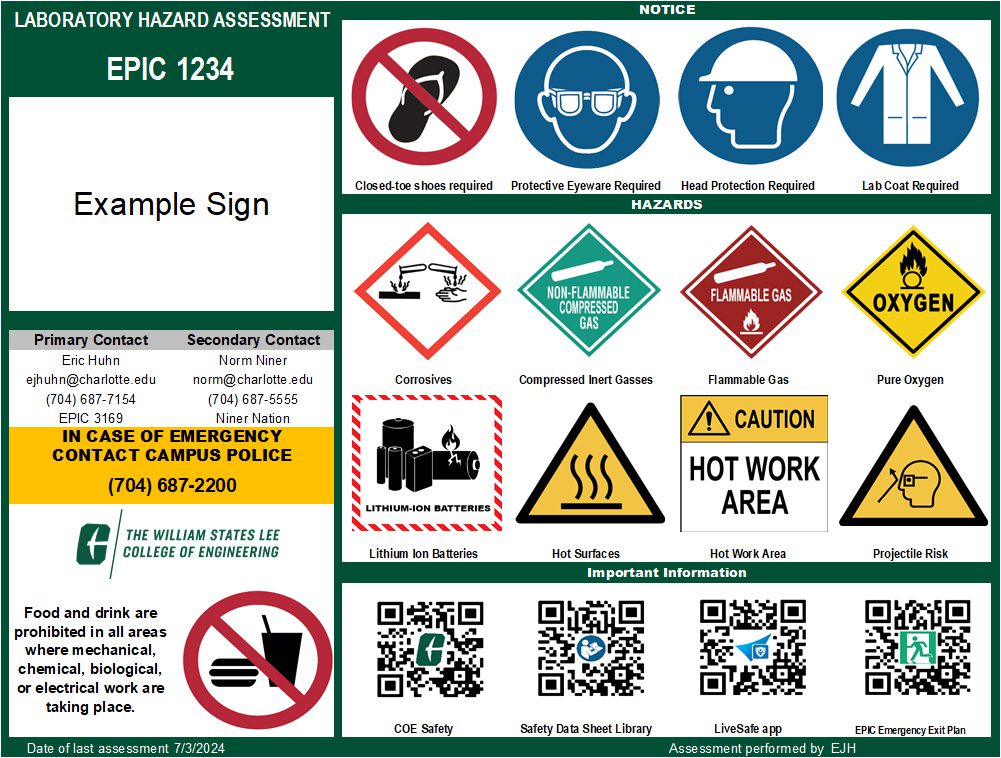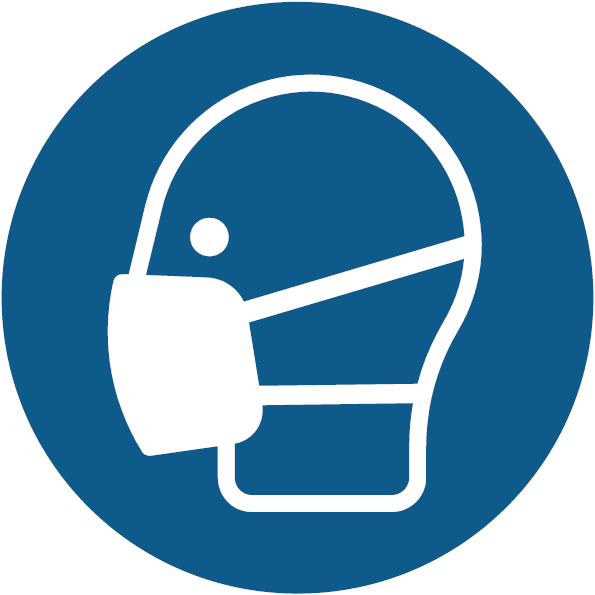Lab Hazard Assessments
Every year, University Environmental Health and Safety (EHS), accompanied by the college’s Facility and Laboratory Safety Engineer, conduct laboratory hazard assessments of all labs and workshops throughout the college. The purpose of these assessments are:
- Confirm occupant information
- Minimize risk of injury or illness to laboratory personnel
- Assess hazards that may be associated with lab activity
- Ensure lab personnel are trained and equipped with information and equipment to work safely in their laboratory environment.
- Assist labs with following local and federal regulations.

Below is a guide for all hazard pictograms that may be shown on a lab hazard sign.

Non-Hazardous Area: This icon indicates that during the hazard assessment no hazardous activities or materials were noted. This sign should not be interpreted to mean that it is impossible to be injured in a space. NO SPACE IS PERFECTLY SAFE.

Compressed Inert Gas: Wherever compressed, bottled air, nitrogen, argon, or other intert gas is present. Refer to the University’s Compressed Gas fact sheet.

Flammable Gas: Compressed, flammable gasses are present. Refer to the University’s Compressed Gas fact sheet.

Oxygen: Pure oxygen is in-use or being stored. Refer to the University’s Compressed Gas fact sheet.

Corrosives: Any space where strong acids or bases are used or stored. Must be enrolled in University’s Chemical Hygiene Plan.

Flammable Liquids: Flammable liquids, or solvents are stored or used.

Oxidizer: Any chemical, other than pure oxygen, that is classified as an oxidizer.

Biohazard: Any space handling biologic material that is subject to the University biosafety program (University policy 714). A BSL lab sign, provided by the University’s biosafety office, must accompany the COE’s lab door sign.

Hot Surfaces: Persons may be exposed to devices or materials that may have a surface temperature of 140°F (60°C) or greater.

Cryogenics: Cryogenic liquids (liquid Nitrogen, etc), or cryogenic freezers in use. Refer to the University’s Cryogenic Material program.

Hot Work Area: Metal welding, cutting, brazing, grinding, or any other activity that may create flying sparks. Or any academic or research work on any material that could result in fire of any magnitude. Subject to the University’s Hot Work Program.

Electricity: Manipulation of live electrical circuits at 50 Volts or greater may be occurring.

Projectile Risk: Tools are in use that may create flying particles, chips, or other debris.

Rotating Equipment: Persons may be exposed to unguarded rotating machinery.

Laser: Class 3b or 4 laser may be in use. Subject to the University’s Laser Safety Program. A laser safety sign, provided by the University Laser Safety Officer, must accompany the Lab Hazard Assessment door sign.

Non-Ionizing Radiation: Strong electromagnetic fields (EMF) may be present.

Radiation Production: Any space where ionizing radiation is produced, or radioactive materials are handled or stored. A radiation safety sign, provided by the University’s Radiation Safety Officer, must accompany the Lab Hazard Assessment door sign. Refer to the University’s Handbook for Radiation Safety.

Overhead Hazards: Cranes or hoists may be in use that can lift or suspend materials overhead.

Trip Hazard: Any space where the floor may be uneven in places, or other ground-level obstacles are present.

Lithium-Ion Batteries: 250 Ah, or greater, worth of lithium-ion batteries are in use or being stored.

High Noise: Any space where the noise level may exceed safe limits as defined by OSHA 1910.95.

Respiratory Hazard: Any material that requires the use of respiratory protection when handling, or a process that requires respiratory protection when in use. Occupants of these spaces are subject to the University’s Respiratory Protection Program. This does not include situations where a person voluntarily wears a filtering facepiece (“N95”) when it is otherwise not required by any material or process. Voluntary use of a filtering facepiece requires completing “Appendix D“.

Reactive Solid: Materials are in use that could be unstable if they come in contact with water.